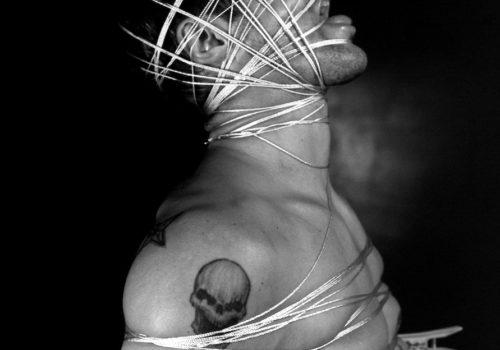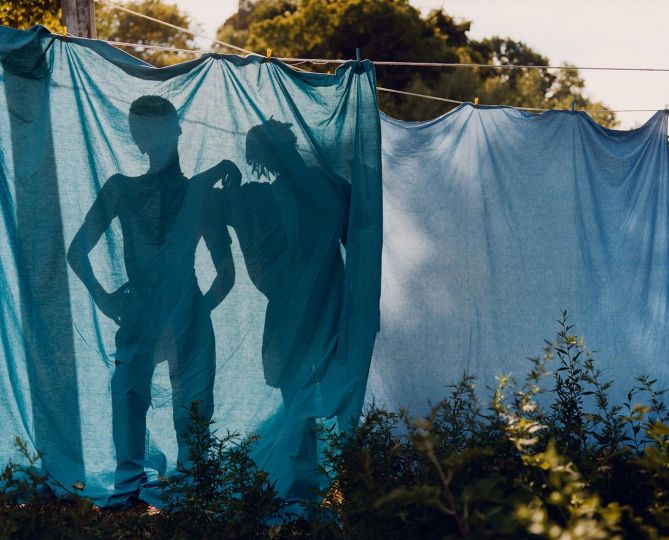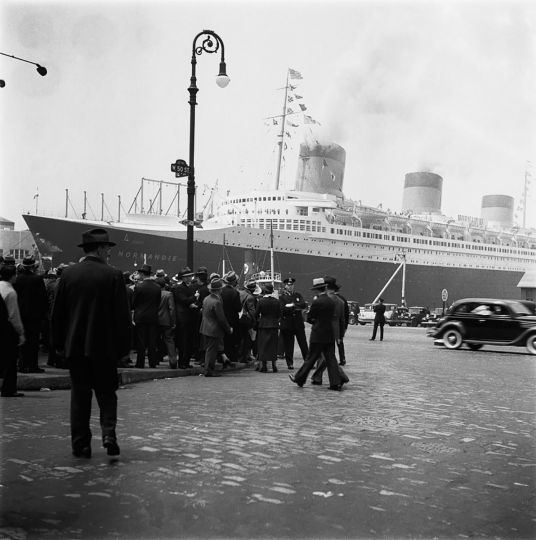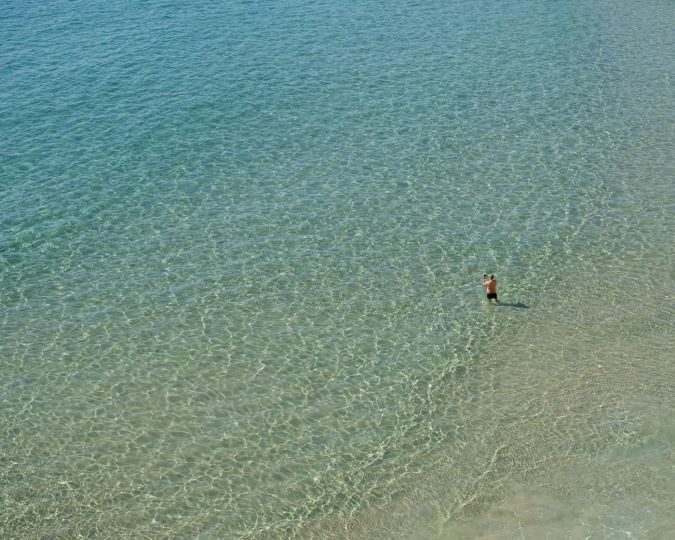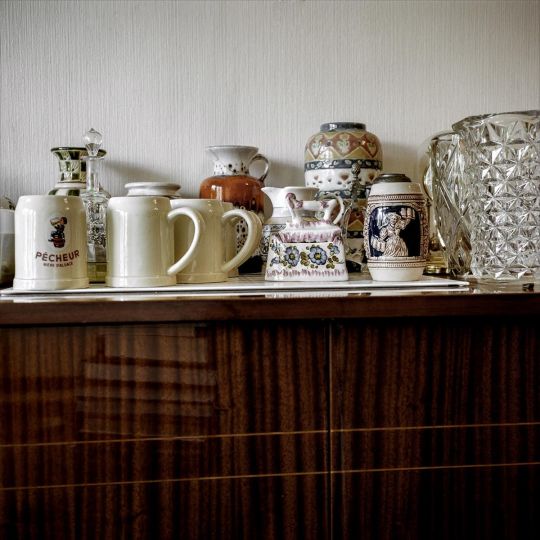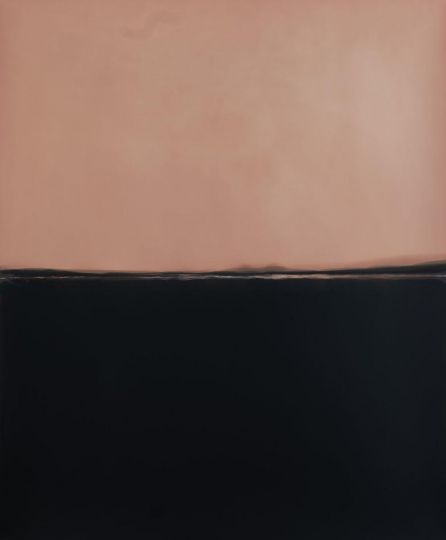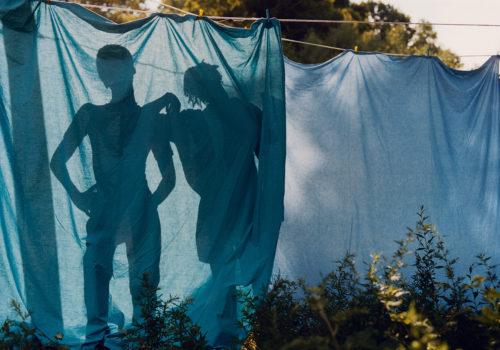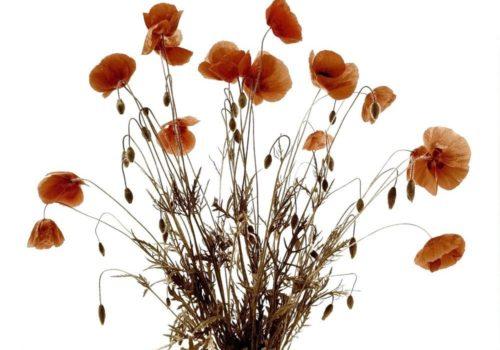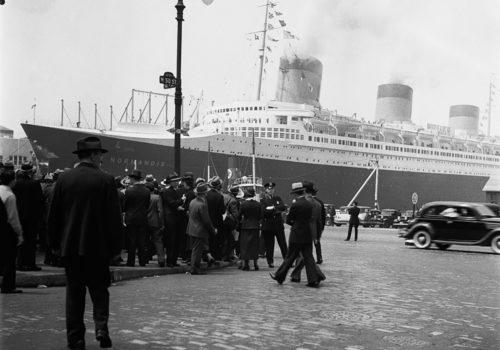I can’t remember the exact moment when I first met Rick Castro online. But I distinctly recall encountering his iconic bondage images of Tony Ward and his renowned tea salons at Tom House in LA. We finally met in person in the summer of 2023 during his exhibition at The Knast, where he presented his photography in a 1906 jail cell. After connecting with him there, we met up again in LA, where Rick gave me a tour of his latest show, Rick Castro Forever, housed in the historic Columbarium at Hollywood Forever Cemetery. Having gained more insight into his provocative work, I felt it was time for a proper recap. Read on for our enlightening discussion!
Nadine Dinter: You are best known for your iconic bondage photography. What first sparked that passion and photographic focus?
Rick Castro: Since I can remember, I’ve been drawn to bondage as my fetish. It’s never been any other way. When I decided to create photographs, it seemed like the perfect outlet for my creativity. At the time, I was working full-time as a wardrobe stylist/designer, a period when you could actually make money in the field. I chose photography as my art over commerce. This meant I could create whatever I liked, and that was fetish.
As a newbie photographer, looking at life through a lens was an exhilarating experience. It’s like seeing the world for the second time. In the early years, I shot anything that moved and then some. By the early nineties, I had fixated on BDSM and street hustlers; that was my most prolific era. When digital came along, I was initially reluctant but eventually gave in. Now that I’m finally at ease with digital and cell phone images, all the youngsters want old-school film and fiber prints. Luckily, I’ve kept a good archive, ensuring the enduring value of my art.
Beginning your career as a clothing designer and fashion stylist, you worked with notable figures like David Bowie, Bette Midler, Interview magazine, and many others. Are there any particularly memorable collaborations that stand out from those early days?
RC: I worked as a wardrobe stylist and designer from 1978 to 1995, spending a significant part of my young adult life working in the “industry.” This era was action-packed with layers of people and stories. It would be impossible to answer that question with just one instance; they all impacted my life in different ways.
I do remember being so enamored of Bowie that I simply made a fool of myself. I was such a fanboy and acted unprofessionally.
An unlikely memory involves styling the wardrobe for David Letterman (I brought him a Letterman jacket; the photographer was Greg Gorman) for the cover of the now-defunct California magazine. He was very nice to me.
As a photographer, highlights include shooting Gore Vidal at his Hollywood Hills home, then having a one-on-one private chat about the impending war on Iraq, his disdain for George W. Bush, and the reality of how insular the American government actually is.
Another memorable moment was an impromptu nude photo shoot with Swiss model Carmilla Caliban Cock and Kenneth Anger at the decaying Al Jolson estate in Palm Springs.
How did your experience working as a stylist shape your creative process? Did it influence how you approach photography conceptually and stylistically, beyond just taking the picture?
RC: For sure, I’m a methodical person when it comes to placement and the overall aesthetic of my images. I clearly see in my mind what I want to achieve within a photo. Years of adhering to forced perfection for commercial standards enabled me to just let things stay raw and not over-styled for my own work.
Back in 1986, photographer Joel-Peter Witkin helped you buy your first camera. How did you two meet? What were your first photographic subjects and concepts?
RC: In 1985, Joel ran an ad soliciting models that read something like this:
I am looking for pinheads, dwarfs, giants, hunchbacks, pre-op transsexuals, bearded women, people with tails, horns, wings, reversed hands or feet, anyone born without arms, legs, eyes, breast, genitals, ears, nose, lips. All people with unusually large genitals. All manner of extreme visual perversion. Hermaphrodites and teratoids (alive and dead). Anyone bearing the wounds of Christ, women whose faces are covered with hair or large skin lesions, willing to pose in evening gowns. People who live as comic-book heroes, boot, corset, and bondage fetishists. Anyone claiming to be God, God.
With this in mind, I attended his first exhibition in Los Angeles, hosted in an empty storefront on the Sunset Strip that would eventually house Book Soup. Approaching him with a selection of my photographs featuring various people I’d been shooting, I asked if he would consider
using them as models. He called me the next morning, expressing an interest in my subject the Goddess Bunny. Joel spent a year working out different scenarios, calling me on a weekly basis, obsessing over ideas for the Goddess Bunny – imagining Bunny on a horse, on a slide, and more. Eventually, we recreated Leda and the Swan with the Goddess. She now hangs in the Louvre. Since then, we’ve created over thirteen images together.
Besides your exceptional focus on bondage & sadomasochistic motifs, your exhibitions stand out for their provocative titles, like Furotica: It Ain’t Exactly Bambi, Mass Murder & A Cute Boy, and the recent one at the Columbarium of the Hollywood Memorial Cemetery, titled Rick Castro Forever. Where do you find inspiration for these bold and distinctive titles?
RC: I know how to turn a phrase and have a bit of a sardonic wit. In regard to RICK CASTRO FOREVER, it’s a pun on the name of the cemetery hosting my exhibition, aptly named Hollywood Forever. Back when I ran the Antebellum gallery, I curated numerous exhibitions with titles like Erotic Pioneers, Modern Heretics, Fools for Feet, and Clownie, Baby, Amputee. Currently, I’m organizing a solo exhibition for Mexico City, CDMX, with the working title, The Nine Lives of Rick Castro – the date TBD.
My inspiration comes from all sorts of sources – anything from noirish films and books to fixation on a lustful guy, or simply a nice cuppa tea.
You shoot mainly in black & white, and your images are known for their striking minimalist composition, which lets the subject matter stand out. How do you plan your work and photo shoots to achieve that? Do you use moodboards, sketches, or other visualization tools?
RC: It comes down to my fixation on the subject. Whatever spark comes from that obsession then translates into the image. It’s all in my head until I get it on film. I do make lists and check them twice.
One of your most famous works is a series featuring the superstar Tony Ward in leather gear. Where and when did you meet Tony, and do you still work together?
RC: Way back in 1985, I was thumbing through a blueboy magazine called In Touch. The centerfold model had a quality beyond the typical pin-up. He exuded a lust that was rare even in a forum for homoerotic porn. I booked him as a model for a photographer I was styling for, Albert Sanchez. During breaks, I shot him against the wall in a leather harness and horsey tail. This marked my first photo in 1986.
When I designed my first menswear collection (Lamy Men, 1986–1988) for Michele Lamy, I brought Tony in as my house model. I used him as a fitting model, on the catwalk, and photographed him in editorials for the collection. Then in 1995, I cast Tony as the lead, Montgomery Ward, for my first feature film as writer/co-director, Hustler White (with Bruce LaBruce). Since then, I’ve photographed him on a regular basis. The last time was with his daughter, Ruby Sato Ward, in 2019 for Another Man UK. This was a recreation of a shoot I did with the father and daughter back in 2005, when Ruby was four years old.
Could you elaborate on your diverse network, which includes notable figures like George Hurrell, Rick Owens, Bruce LaBruce, and Greg Gorman, and organizations like the Tom of Finland Foundation (TOFF)?
RC: I met most of these people on a professional basis. In regard to Hurrell, I was booked to work with him through my agent, Chantal Cloutier, in 1985. At the time, I was surprised he was still alive and working. Apparently, he had just been rediscovered by Interview magazine. My association with Gorman stemmed from my role as a wardrobe stylist, working on numerous album covers and film publicity.
LaBruce, I met through zine culture. We did the first zine convention in Los Angeles together (SPEW 2 at LACE, 1992). I then shot my first footage for his second film, Super 8 1/2 (1994), and co-wrote/directed Hustler White (1996).
My collaboration with TOFF goes way back to the early days, including my relationship with its president, Durk Dehner, who was my first collector and the publisher of my first book, Castro (1991, DPR press).
Owens was my boyfriend for a spell. Later, I brought him in as the patternmaker for my menswear line for Michele Lamy called Lamy Men. When he launched his own collections, Rick used my photo – Mr. Bean Bag – as the invitation for his first womenswear fashion show in LA (2002). BTW- Owens told me everybody freaked out over the image. He said, “Nobody got it. The only person that liked it was Kate Moss.” I replied, “Well that’s all that matters.” I shot his first menswear collection in Pitti, Florence (2006). I photographed his menswear lookbook for 2014, featuring my 93-year-old father as a model, and continue to shoot for him every now and again.
What’s next on your agenda?
RC: On 21 February 2024, I will present a slide show and lecture at the Los Angeles Central Library Photographers Eye program. This is a significant milestone for me to be presented in such a mainstream forum like the city library. I have residual trauma from defending my work since the beginning. I’m not yet used to this newfound acceptance of what has always been my goal: To present a homoerotic/queer/fetish point of view to the general public for exactly what it is – art.
Currently, my photography and writings are featured in the historic exhibition Copy Machine Manifestos: Artists That Create Zines at the Brooklyn Museum in New York (through 31 March 2024). I’m proud to have representation in a medium that finally receives recognition for impacting art and culture pre-internet. In the past, if you wanted to reach like-minded people, you did it yourself – DIY. The exhibition, consisting of 1400 items, will then travel to Vancouver, British Columbia.
I’m in the process of reconfiguring RICK CASTRO FOREVER into a permanent museum at the historic Columbarium of Hollywood Forever Cemetery. This will be a smaller version of RCF that will include a shrine to Oscar Wilde, and my own personal niche with my death mask (even though I’m still amongst the living). This will be a self-guided tour during regular cemetery hours, with private walk throughs and tea salons scheduled every so often. The new title is Columbarium Continuum by Rick Castro.
I’m organizing a fetish tea salon with French ceramicist Frederick Gautier during March at the Tom of Finland house. He will create all the tea ware.
I do love France and hope to be back in 2024. I have good memories as one of the artists featured in AllTogether: Archives from the Tom of Finland Foundation, which showed in May–June 2022 at The Community Centre in Pantin, Paris.
What’s your advice for the new generation of photographers?
RC: Deeply look and truly see your subject. If you do that, you’ll always have great results.
Unless you’re a commercial photographer, don’t make money the goal of your photographic vision.
Upcoming show & events:
Photographer’s Eye: Rick Castro S/M Blvd- Street Hustler Photographs- Los Angeles Central Library – 21 February – more at: http://photofriends.org/
Copy Machine Manifestos: Artists who makes Zines- Brooklyn Museum, NY through 31, March.- https://www.brooklynmuseum.org/exhibitions/copy_machine_manifestos_artists_who_make_zines
Rick Castro S/M Blvd: Street Hustler Photographs and Remembrances-1986-1999-
https://www.allnight-menu.com/shop/rick-castro-sm-blvd
Columbarium Continuum by Rick Castro- Hollywood Forever Cemetery-
https://hollywoodforever.com/event/rick-castro-forever/
Rick Castro is a photographer, filmmaker, writer, and third-generation Los Angeleno.
More information at: instagram.com/castrrick

